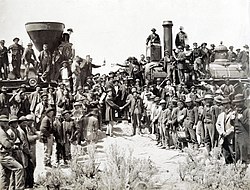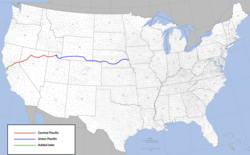
Back أول سكة حديدية ممتدة عبر القارة Arabic Primer ferrocarril transcontinental d'Estaos Xuníos AST Першая транскантынентальная чыгунка Byelorussian Първа трансконтинентална железница Bulgarian Primer ferrocarril transcontinental dels Estats Units Catalan First Transcontinental Railroad German ބައްރުތައް ކަނޑަތުކޮށް ދަތުރުކުރާ ފުރަތަމަ ރޭލުމަގު DV Πρώτος διηπειρωτικός σιδηρόδρομος Greek Primer ferrocarril transcontinental de Estados Unidos Spanish اولین راهآهن بینقارهای Persian
| First transcontinental railroad | |||
|---|---|---|---|
 | |||
| Overview | |||
| Other name(s) | Pacific Railroad | ||
| Owner | U.S. government | ||
| Locale | United States | ||
| Termini |
| ||
| Service | |||
| Operator(s) | Central Pacific Union Pacific | ||
| History | |||
| Opened | May 10, 1869 | ||
| Technical | |||
| Line length | 1,912 mi (3,077 km) | ||
| Track gauge | 4 ft 8+1⁄2 in (1,435 mm) standard gauge | ||
| |||
America's first transcontinental railroad (known originally as the "Pacific Railroad" and later as the "Overland Route") was a 1,911-mile (3,075 km) continuous railroad line built between 1863 and 1869 that connected the existing eastern U.S. rail network at Council Bluffs, Iowa, with the Pacific coast at the Oakland Long Wharf on San Francisco Bay.[1] The rail line was built by three private companies over public lands provided by extensive U.S. land grants.[2] Building was financed by both state and U.S. government subsidy bonds as well as by company-issued mortgage bonds.[3][4][5][N 1] The Western Pacific Railroad Company built 132 miles (212 km) of track from the road's western terminus at Alameda/Oakland to Sacramento, California. The Central Pacific Railroad Company of California (CPRR) constructed 690 miles (1,110 km) east from Sacramento to Promontory Summit, Utah Territory. The Union Pacific Railroad (UPRR) built 1,085 miles (1,746 km) from the road's eastern terminus at the Missouri River settlements of Council Bluffs and Omaha, Nebraska, westward to Promontory Summit.[7][8][9]
The railroad opened for through traffic between Sacramento and Omaha on May 10, 1869, when CPRR President Leland Stanford ceremonially tapped the gold "Last Spike" (later often referred to as the "Golden Spike") with a silver hammer at Promontory Summit.[10][11][N 2] In the following six months, the last leg from Sacramento to San Francisco Bay was completed. The resulting coast-to-coast railroad connection revolutionized the settlement and economy of the American West.[N 3][N 4] It brought the western states and territories into alignment with the northern Union states and made transporting passengers and goods coast-to-coast considerably quicker, safer and less expensive.
The first transcontinental rail passengers arrived at the Pacific Railroad's original western terminus at the Alameda Terminal on September 6, 1869, where they transferred to the steamer Alameda for transport across the Bay to San Francisco. The road's rail terminus was moved two months later to the Oakland Long Wharf, about a mile to the north, when its expansion was completed and opened for passengers on November 8, 1869.[15][16][N 5] Service between San Francisco and Oakland Pier continued to be provided by ferry.
The CPRR eventually purchased 53 miles (85 km) of UPRR-built grade from Promontory Summit (MP 828) to Ogden, Utah Territory (MP 881), which became the interchange point between trains of the two roads. The transcontinental line became popularly known as the Overland Route after the name of the principal passenger rail service to Chicago that operated over the length of the line until 1962.[19]
- ^ Vernon, Edward (Ed) "Travelers' Official Railway Guide of the United States and Canada" Philadelphia: The National General Ticket Agents' Association. June, 1870, Tables 215, 216
- ^ Pacific Railroad Act of 1862, §2 & §3
- ^ Pacific Railroad Act of 1862, §5 & §6
- ^ "First Mortgage Bonds of the Central Pacific Railroad, 1867". www.cprr.org. Archived from the original on January 26, 2019. Retrieved January 26, 2019.
- ^ "CPRR Ephemera and Collectibles – $1,000 Pacific Railroad Bond, City and County of San Francisco, June 24, 1864". www.cprr.org. Archived from the original on January 26, 2019. Retrieved January 26, 2019.
- ^ "Report on the Pacific Railroads", US House of Representatives, Committee on the Judiciary, House Ex. Doc. #440, 44th Congress, First Session, April 25, 1876, pp. 3, 6
- ^ Executive Order of Abraham Lincoln, President of the United States, Fixing the Point of Commencement of the Union Pacific Railroad at Council Bluffs, Iowa, dated March 7, 1864 (38th Congress, 1st Session SENATE Ex. Doc. No. 27).
- ^ Cooper, Bruce C., "Riding the Transcontinental Rails: Overland Travel on the Pacific Railroad 1865–1881" (2005), Polyglot Press, Philadelphia, ISBN 1411599934. p. 11.
- ^ "Appleton's Railway and Steam Navigation Guide". New York: D. Appleton & Co., December 1870. p. 236.
- ^ Bowman, J. N. "Driving the Last Spike at Promontory, 1869 California Historical Society Quarterly, Vol. XXXVI, No. 2, June 1957, pp. 96–106, and Vol. XXXVI, No. 3, September 1957, pp. 263–274.
- ^ Hill, Thomas "The Last Spike" San Francisco: Thomas Hill (privately published). January 1881.
- ^ Letter from Charles F. Conant, Assistant Secretary, US Department of the Treasury, to US Rep. William Lawrence (R-OH8), March 9, 1876
- ^ Letter from Z.B. Sturgus, Chief, Lands and Railroad Division, Office of the Secretary, US Department of the Interior, to US Rep. William Lawrence (R-OH8), April 28, 1876
- ^ Speech by Rep. William A. Piper (D-CA1) in the US House of Representatives, April 8, 1876
- ^ Works Progress Administration (2001). San Francisco in the 1930s: The WPA Guide to the City by the Bay. Berkeley: University of California Press. p. 32. ISBN 978-0520948877.
- ^ Scott, Mel (1985). The San Francisco Bay Area: A Metropolis in Perspective (2nd ed.). Berkeley: University of California Press. p. 50. ISBN 978-0520055124.
- ^ "Pacific Railroad Officially Completed on November 6, 1869". cprr.org.
- ^ "Union Pacific R. Co. v. United States, 99 U.S. 402, 25 L. Ed. 274, 1878 U.S. LEXIS 1556 – CourtListener.com". CourtListener.
- ^ Cooper, Bruce Clement (Ed), The Classic Western American Railroad Routes. New York: Chartwell Books (US) / Bassingbourn: Worth Press (UK); 2010. ISBN 978-0785825739; BINC: 3099794. pp. 44–45.
Cite error: There are <ref group=N> tags on this page, but the references will not show without a {{reflist|group=N}} template (see the help page).
© MMXXIII Rich X Search. We shall prevail. All rights reserved. Rich X Search
